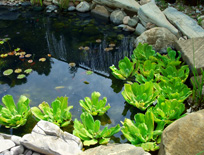Pond Liners and the Sun

As I peruse my expert-witness files to develop these “Lessons Learned” items, sometimes I run across situations so remarkably silly that I’m reminded why they originally made me scratch my head and marvel at the incompetence I encounter from time to time.
In the spirit of covering a broad range of situations, allow me to share one such case that definitely qualifies as an obvious misstep – one involving a pond liner and its most basic environmental nemesis, sunlight.
Scenario: When rubber liners are used in pond construction, competent installers will first place an underlayment fabric to relieve concerns about soil off-gassing and protect the material from the wear and tear that can erupt with rocks, roots and other intrusions. Basically, it’s an affordable form of insurance that will increase the liner’s longevity as well as that of the pond.
Competent installers also know that rubber liners—which typically are 45 mils thick—are warranted only if they are protected from the damaging effects of the sun’s ultraviolet radiation. This means that the liner must be fully covered by gravel, sand or other material; it even leads some installers to top the liner with concrete in key places along the edges.
If you treat them right, these liners will last a good 15 years or more. Expose them to sunshine and they’ll start breaking down in a year or two.
In the case at hand, however, not only did the installer leave the liner exposed on the edges, he also nailed one of its sides to the footings of a deck positioned at the edge of the pond. Needless to say, his two transgressions resulted in the rapid deterioration of the liner and a pond that did not hold water when filled to its proper level.
The Fix: Unfortunately, solving the problem involved removing the entire liner and basically starting over, which meant pulling out both the plants and the rockwork on the edges. But this time, the pond was installed correctly, with all surfaces properly shielded from the sun, and nails banned from the job site.
Lesson Learned: It is often said that you should make sure you know what you’re doing before you do it. That’s self-evident in this case, but there’s an even sharper point: Nails and rubber are never a good pairing!
Scott Cohen is president and supervising designer of The Green Scene, an outdoor design and construction firm based in Northridge, Calif. He provides consultation for clients nationwide and gives seminars on designing landscapes, swimming pools and outdoor kitchens. For more information, go to www.greenscenelandscape.com










